What are chives?
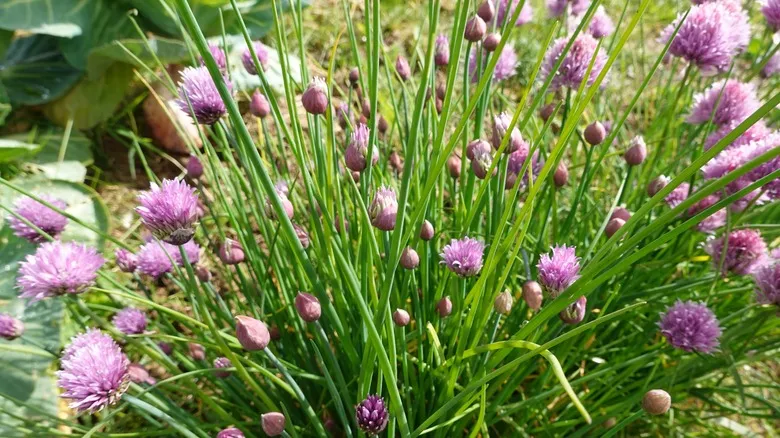
Despite their appearance resembling narrow, round-bladed grass, chives (Allium schoenoprasum) are actually part of the Allium genus and the amaryllis family (Amaryllidaceae). This family also includes garlic, shallots, scallions, leeks, and onions, which accounts for their strong, onion-like flavor. While there are many other varieties of alliums, most are not cultivated as food crops. Additionally, there are various allium species worldwide that may be less known to Americans, yet chives remain one of the most favored alliums in American gardens.
Chives grow in a clumping formation, and both their flowers and green stalks are edible. The leaves, which resemble blades more than traditional leaves, sprout from the base of the plant as it emerges from the soil. Thanks to their clumping growth and adaptable nature, chives are commonly found in pots, both indoors and outdoors. The leaves can be used fresh or dried, making chives a popular seasoning and garnish.
A brief history of cultivation and use

Chives have long been a part of the human diet. Their exact origins are somewhat unclear, but they are believed to be native to certain regions of Asia and Europe. While some suggest they may have originated in North America, it’s possible they simply adapted to that environment long ago.
Regardless, chives have been cultivated in China for over four thousand years. The Ancient Greeks also grew them, which contributed to their spread across Europe during the medieval period. In the 1600s, chives made their way to the Americas, where they were valued for both culinary and medicinal uses. Today, they are primarily found in grocery stores and home gardens for their culinary applications.
The flavor of chives
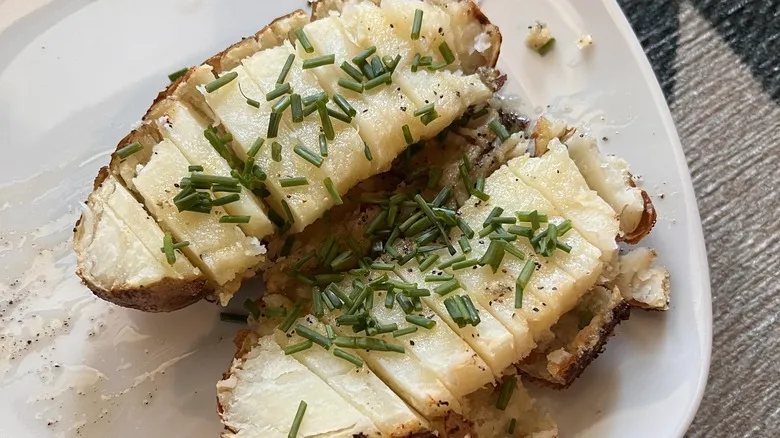
Staying true to their allium roots, chives have a flavor reminiscent of mild onions with a hint of garlic. If you enjoy these other tastes, chances are you'll appreciate chives as well. One of their standout qualities is their mildness, allowing you to consume them raw in relatively large amounts without any adverse effects on your tongue or mouth. However, they can trigger heartburn, so those sensitive to alliums should exercise caution with chives.
The flowers are also quite flavorful, albeit with a gentler taste. If you cultivate your own chives, don’t forget to incorporate these blossoms into your dishes. They can be floated on soups, tossed into salads, or used as a garnish to your liking. When shopping for chives at the farmers market, don’t hesitate to ask vendors if they have chives with flower heads. They typically sell them as just the leaves, but if you build a rapport, they might be willing to provide them with the blooms still attached.
Common varieties of chives
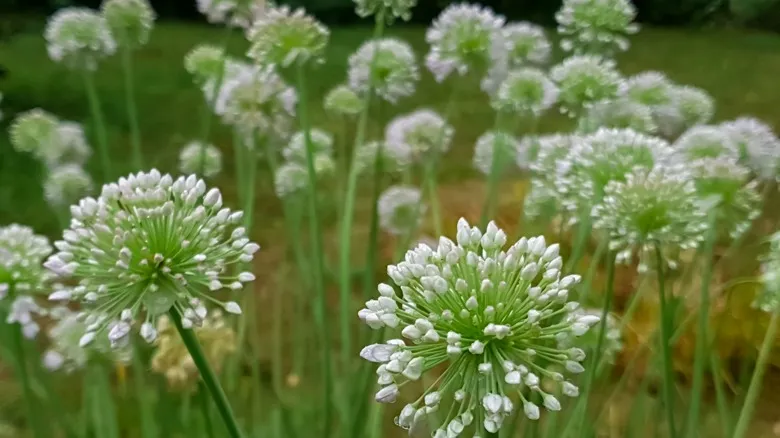
In addition to the common chives, which are the most prevalent in gardens (hence their name), the three most popular varieties include garlic chives (Allium tuberosum), Siberian garlic chives (Allium nutans), and giant Siberian chives (Allium schoenoprasum sibiricum). If it seems like many chives originate from Siberia, that's because they do. These chives thrive in meadows, showcasing large purple flower heads and a delightful onion flavor.
The giant variety can reach heights of up to 20 inches, with flower heads resembling starbursts rather than the small round puffballs typical of common chives. Despite their larger size, they share the same mild onion taste as regular chives. The other three varieties can be a bit more challenging to find. If you're looking for a variety of options, you may need to cultivate them yourself, either from seeds or seedlings.
Available forms of chives

Chives are most flavorful when they are fresh. If you can't find a fresh supply, you can purchase them at the grocery store or order them online for same-day delivery. Look for chives in the produce section, alongside other fresh herbs like parsley, cilantro, and thyme.
Dried chives are also available for purchase. Freeze-dried chives are a convenient way to enjoy their onion-like flavor throughout the year. Like fresh chives, you can find these both online and in stores. They are affordable and delicious, making them ideal for sprinkling on baked potatoes or incorporating into soup bases when fresh chives are unavailable.
You can even dry chives at home by using a dehydrator. If you don’t have one, you can chop fresh chives and place them in the oven at a low temperature, ideally around 100°F. If your electric oven doesn’t reach that low, simply turn it on and then off again. For a gas oven, you can use the same technique. Be sure to use a thermometer to check the oven's temperature.
Chives versus scallions and spring onions
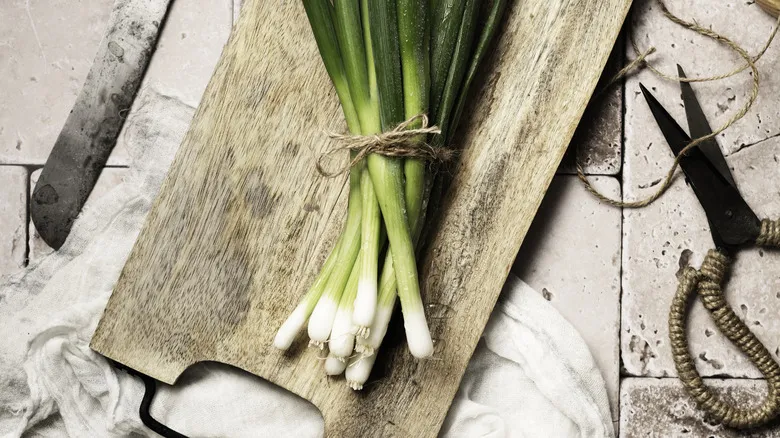
Many individuals find it challenging to distinguish between chives and scallions (commonly referred to as green onions). This confusion is understandable, as both plants grow in a similar upright, clumping, grass-like manner. However, they are quite distinct from one another.
Scallions are noticeably thicker and feature a bulbous white base that resembles a slender above-ground bulb. In contrast, chives have a white base that is much narrower and appears closer to the ground. Additionally, scallions have a prominent white section that gradually transitions from light green to dark green along the stem, while chives' white base is less pronounced and situated near the soil.
It's important to note that chives are not the same as spring onions, which, as their name implies, are harvested in the spring. Spring onions are simply young, immature versions of the bulb onions typically found in grocery stores and can be found in white, yellow, and red varieties.
How to choose and clean chives
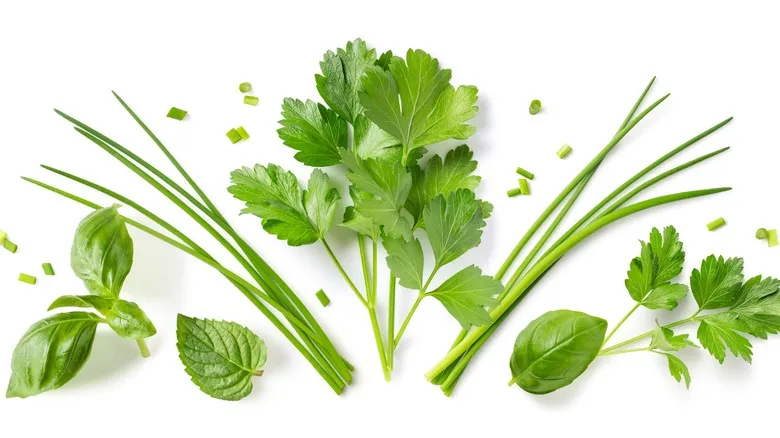
When selecting herbs from your garden, a farmers market, or a store, opt for fresh, unblemished stems. Steer clear of any that appear dried, wilted, yellowed, or slimy. Only purchase or harvest what you need, as chives and other fresh herbs have a short shelf life once you bring them home.
Upon bringing them home, wash the herbs under cool running water. Avoid using any detergents, as they are more likely to cause illness than to effectively remove harmful dirt or bacteria. After washing, shake them off thoroughly or use a salad spinner to ensure they are dry. This is crucial if you plan to store them or use them in a recipe where excess moisture is undesirable.
If you intend to eat the blossoms, rinse them well under running water and then place them on a towel to dry until you're ready to use them. Alternatively, you can submerge them in a bowl of clean water, which will help dislodge any bugs and dirt trapped inside the flowers.
How to prepare chives
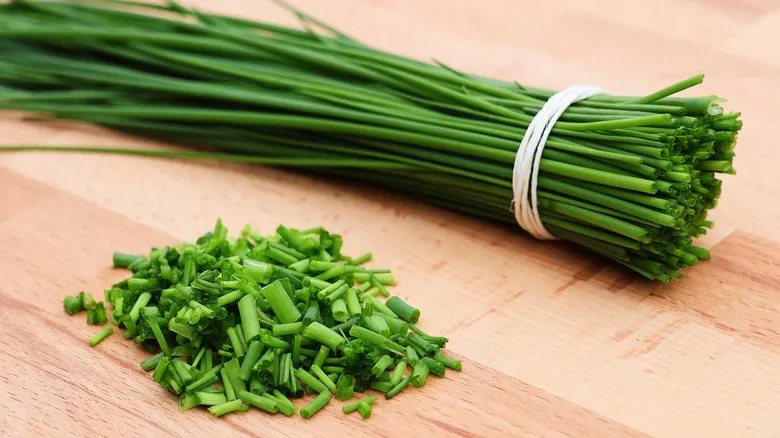
Slicing chives accurately isn't too difficult. Just arrange them on a cutting board and trim the ends of the stems, discarding any white sections and any dried or discolored tips. Chop them into small pieces to use as a base in cooked dishes or as a garnish on top.
Using a sharp knife is essential for a clean cut and an appealing presentation. If you’d rather not use a knife, a sharp pair of kitchen scissors can do the job.
There are several techniques to cut onions without shedding tears. Although chives are milder and less likely to cause irritation, you might still experience some eye discomfort. To minimize this, you can try freezing them beforehand, turning on a kitchen fan, cutting near an open flame, or even cutting them underwater. Some of these methods may require extra effort, but they’re worth a shot!
Common uses for chives in the kitchen
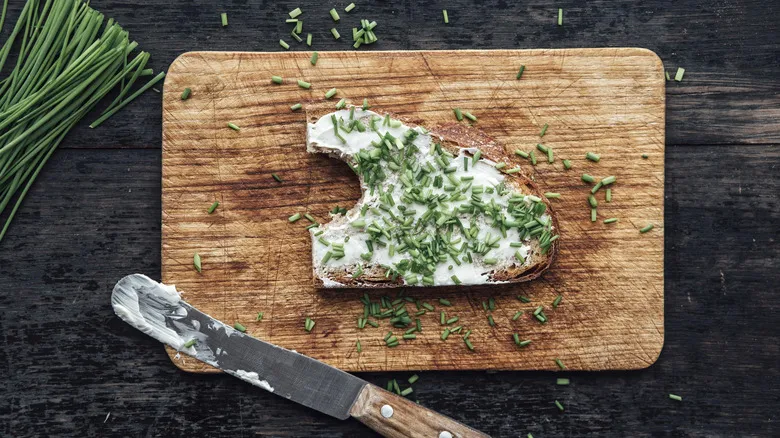
Both fresh and dried chives are incredibly versatile in the kitchen. With their delightful yet subtle onion taste, they are perfect for a variety of savory dishes. Chives make an excellent seasoning for salmon burgers, enhancing the fresh and sweet flavor of the fish. They also elevate potato skins, making them a great topping for soups.
If you haven't tried adding chives to savory pancakes, it's definitely worth a shot. They also provide a wonderful enhancement to mashed potatoes when chopped and mixed in with butter and cream.
Just a quick note: when cooking chives, be careful not to heat them for too long, as they can quickly lose their flavor and vibrant green color. It's best to add them at the end of cooking or use them as a garnish.
Growing your own chives
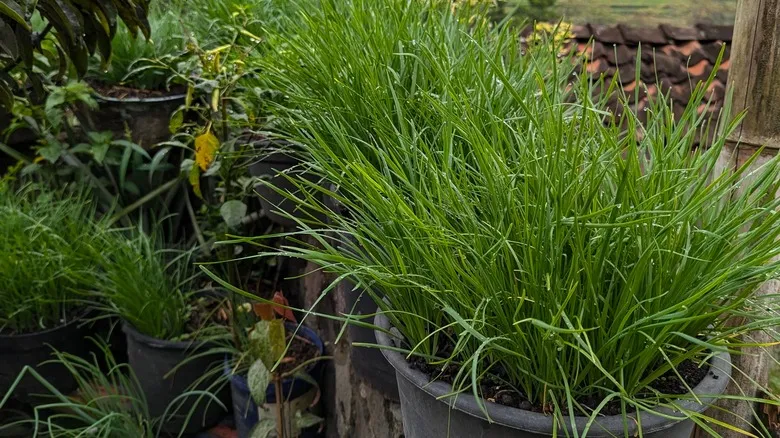
Chives can be cultivated both indoors and outdoors. When grown outside, they flourish in U.S. Department of Agriculture zones 3-9, returning each year in vibrant green clusters. In areas with lower or higher zones, they can be grown as annuals. If garden space is limited, you can use quality potting soil and place them in a well-lit spot indoors, such as a sunny windowsill. To propagate chives, simply dig up the clump, separate it into smaller sections, and replant them.
If you want to grow chives yourself, starting with seeds is a straightforward option. Just begin by sowing them indoors in the spring, and then transplant them outside once the soil has warmed up. For starting seeds indoors, you'll need a few supplies. First, seed trays are essential, as they allow you to plant chive seeds in small cells, making it easy to remove seedlings for later transplanting. Additionally, a grow light is important; unless you have a very sunny window that provides ample light during winter, you’ll likely need to use artificial lighting to support the seedlings' growth.
Once established in their first year, chives will return year after year, eliminating the need to start them indoors again, unlike many other vegetables or annual herbs.
How to harvest chives
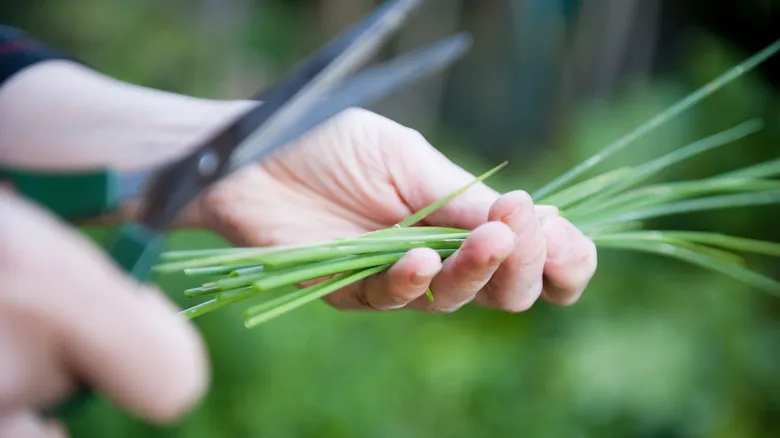
Harvesting chives can be quite simple. Take a handful from the middle of the plant and hold it securely while you use sharp scissors to snip them off at the base. You can start harvesting chives as soon as 30 days after planting, and you can continue to pick them throughout the growing season. For more precise timing, wait 30 days after transplanting seedlings outdoors, or 60 days if you sow them directly in the ground. You can also gauge readiness by height, harvesting when the plants reach about six inches tall.
While some suggest avoiding the complete harvest of the plant at once to ensure regrowth for the next year, we have found this to be overly cautious. In our experience, even aggressive harvesting hasn’t harmed the chives in our garden, so if you’re not too concerned, feel free to cut as many stalks as you wish at one time. After the flowers have finished blooming, trim them off at the base of the stalk.
If your chives are becoming unruly in your garden, you can trim them back at any time. Remove the outer stalks while keeping the center intact, similar to how you would prune other plants—this will allow more light and air to reach the remaining foliage.
Health benefits of chives
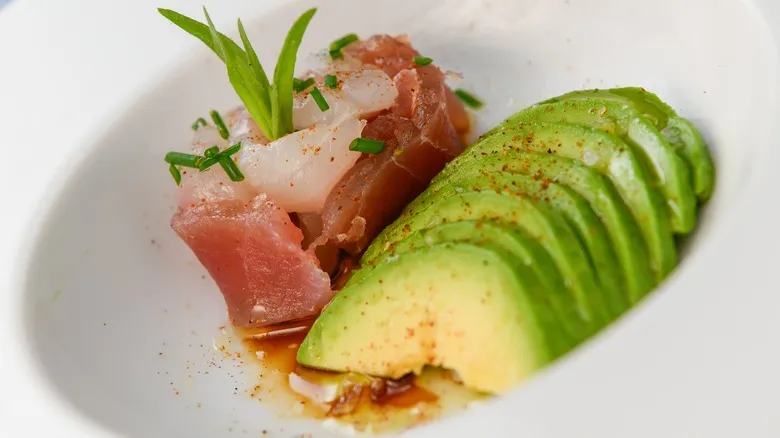
Chives offer numerous nutritional advantages, including high concentrations of phytonutrients, which are plant-derived nutrients. These compounds can be beneficial for various health issues, including heart disease and diabetes. Similar to other alliums, chives contain substances that may inhibit the growth of cancer cells, with sulfur being the most prominent.
Essentially, chives are a low-calorie food, with just 0.9 calories in a tablespoon of chopped chives. They are rich in several vitamins and minerals, such as vitamin K, vitamin C, vitamin A, folate (a B vitamin), calcium, and potassium. Vitamin K, in particular, plays a crucial role in maintaining bone density. However, since chives do not provide large quantities of these nutrients, it's important to incorporate them and other alliums into your diet whenever possible.
Additionally, chives are a source of choline, which can help regulate mood, enhance sleep quality, improve memory, and assist with muscle control. It may also support various functions of the nervous system and brain.
Interestingly, the flowers of chives also offer nutritional benefits. They are a good source of vitamins C and E and contain significant amounts of antioxidants. Since we often eat with our eyes first, chive blossoms make a healthy and visually appealing addition to any dish.
Storing chives to last
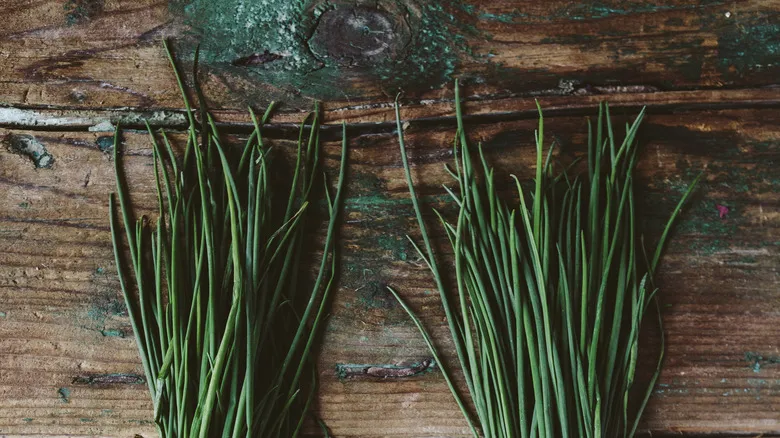
Ideally, you should only harvest or purchase as many chives as you can use at one time. If you need to buy them but won't be using them immediately, place them in a jar with an inch of water and cover it loosely with a plastic bag. Then, store the jar in the refrigerator, where they can remain fresh for up to a week. Alternatively, you can freeze chives in a plastic bag for three to six months, but keep in mind that their texture will change, so it's best to use them in cooked dishes if you choose this method.
For storing dried chives, it's most effective to keep them in a dark glass jar, away from moisture, light, and heat. If you're harvesting and drying your own herbs, ensure you use high-quality spice jars. Jars with loose lids can cause the dried chives to oxidize, leading to a rapid loss of flavor.
Recommended

The Clever Way To Store Your Ice Cream To Prevent Freezer Burn
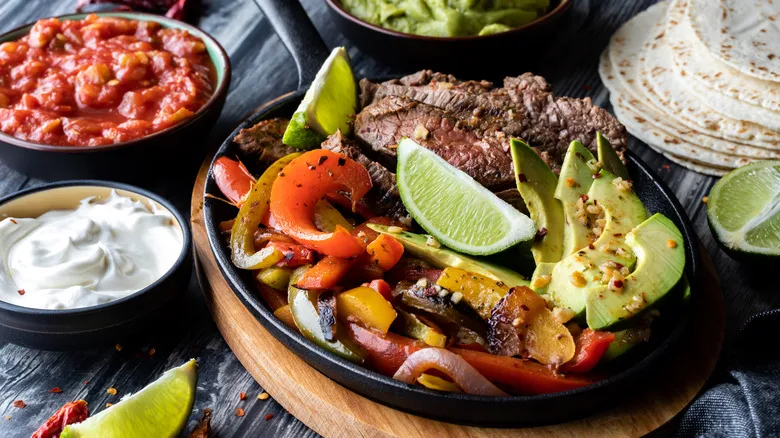
What's The Best Cut Of Steak For Sizzling Fajitas?

Don't Forget To Clean Your Kitchen's Knife Block
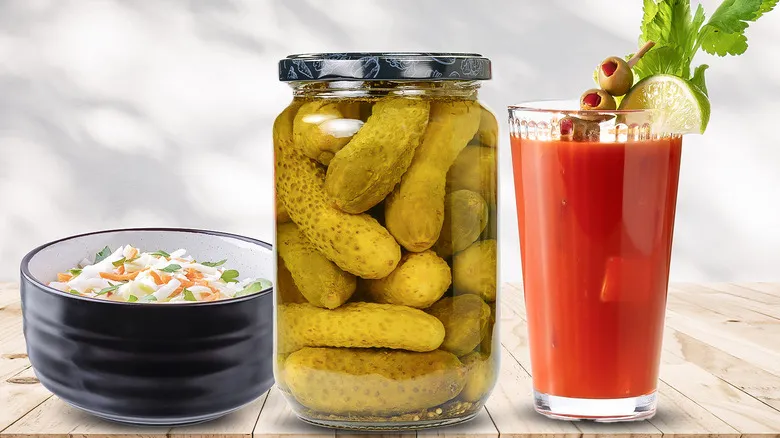
12 Simple Ways To Use Leftover Pickle Juice
Next up

